

Red spider mite is a tiny mite of the Tetranychidae family. This sap-sucker infects indoor and outdoor plants.
Red spider mite facts
Name – spider mite, red spider
Family – Tetranychidae
Danger to plant – fatal if too many
Side effects – may cause viral diseases
Appears in – spring & fall (year-round indoors)
Spread – fast (crawls, wind-carried)
Treatment – moisture & biocontrol
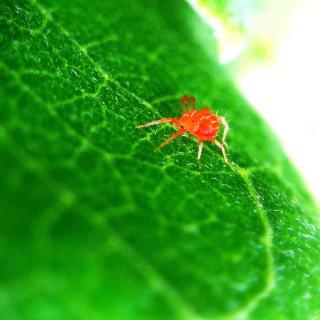 The term “spider” is misleading: this is a mite. However, it does have 8 legs, spins webs, and is related to the same animal family as spiders, Arachnida.
The term “spider” is misleading: this is a mite. However, it does have 8 legs, spins webs, and is related to the same animal family as spiders, Arachnida.
A few red spider mites will only cause little damage. Too many, though, can kill a plant in a couple months.
Here’s how to eliminate red spider mites with organic treatments.
→ These treatments also work against scale insects
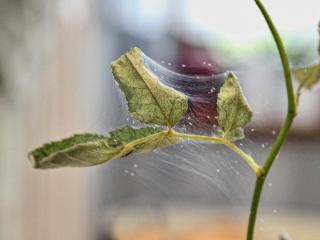 Their tiny size (half a millimeter or 1/64″) makes spider mites very difficult to see with the naked eye, but a small magnifying glass lifts any doubt. Red spider mites feed on sap, sucking it out of leaf cells.
Their tiny size (half a millimeter or 1/64″) makes spider mites very difficult to see with the naked eye, but a small magnifying glass lifts any doubt. Red spider mites feed on sap, sucking it out of leaf cells.
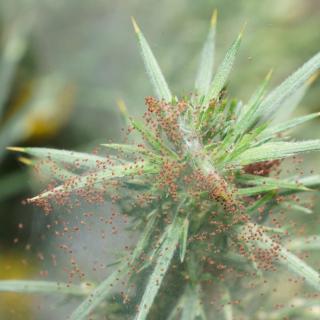 Also, they weave small webs around the leaves, another telltale sign.
Also, they weave small webs around the leaves, another telltale sign.
Webs protect spider mites from predators and keeps humidity out.
→ Other webby pests: processionary & boxwood moth
As mentioned earlier, red spider mites love it when the air is very dry. And the antidote to dryness is 💦 moisture 💦 !
→ Water treatments should be repeated daily, and other forms are best repeated every 2-3 weeks to get rid of new hatchlings.
→ Although red spider mites rarely cause severe damage, check on your plants often, especially in hot, dry weather. That is when they reproduce fastest.
On houseplants, getting rid of them is straightforward:
Hosing down & showering flushes red spider mite away.
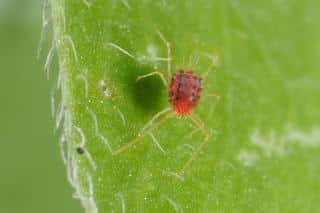 Again, spraying soft water regularly for a few days is usually enough to dislodge small colonies.
Again, spraying soft water regularly for a few days is usually enough to dislodge small colonies.
Biological control is effective and doesn’t require daily work. You can find these online or in stores, but in the long run it’s best to make your garden attractive for all sorts of animals and insects.
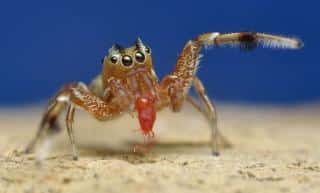 Spiders (real ones this time) also devour red mites.
Spiders (real ones this time) also devour red mites.Essential oils/extracts kill both red spider mites and their eggs.
Trials show that many natural pesticides help get rid of the pest. Pyrethrum-based insecticides are a good example of this. Also, below, you’ll discover a list of spider-mite repelling plants and herbs.
Red spider mites multiply and attack plants when the weather is hot and dry.
That’s why they are found indoors all year round and in the garden in summer, when it doesn’t rain and temperatures stay above 70°F (20°C).
⚠️ These spiders aren’t insects! ⚠️
Using pesticides contributes to their spread:
A spider mite’s lifespan is 4-7 weeks. They reproduce very quickly, like scale and aphids, so an invasion is devastating if not caught early. A healthy plant can be overrun in about 6 week’s time, if not treated.
Certain plants repel red spider mite near where they’re planted. Such protection usually extends about 3 feet (one meter) around the healthy, mature plant.
Many herbs repel spider mites: Garlic, rosemary, cinnamon, peppermint, lemongrass, chamomile, marjoram, horseheal (Inula helenium), thyme, caraway, certain Curcuma varieties
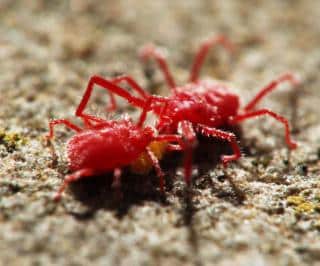 Not all tiny red bugs are bad. For example, the two pictured here are velvet mites. They’re beneficial insectivores that eat other pests.
Not all tiny red bugs are bad. For example, the two pictured here are velvet mites. They’re beneficial insectivores that eat other pests.
These soft-looking velvet spiders don’t have any typical Tetranychus long hairs on their body, so don’t eliminate them. They’re great helpers to have in the garden to control pests!
Excellent article! I was wondering where the little spider webs came from on the top flowers and seed pods of my hibiscus plant. Some of these leaves have turned yellow and fell off. It is never outside and there have never been any new potted plants introduced into the house in years. Also, after another wonderful bloom on my 2 poinsettias this year (6 and 7 years old plants), most of the leaves on both are now falling off. I’m wondering if they might also have mites. I’ll certainly check that option tomorrow in better light. I’ll spray all of them down with that 70% alcohol which should be available at the local pharmacy. Thanks, Doug.
Your photo of 2 red mites are not spider mites, but velvet mites, completely different creatures. These are often beneficial, as their nymphs eat pest insects.
You’re correct Niel and I thank you for taking the time to correct me. I added a few new pictures and rewrote part of the article to also explain the difference between spider mite and velvet mite (the hairs on their body). As you say, velvet mites are very beneficial – they even help control spider mites! Thanks again for having taken the time to share your insight, I appreciate that!
Hello, I am new to your site, and I like your advise. I know it sounds crazy, but I do look for damaged, and uncared for plant, as as a challenge, I try to save them. I do receive a discount for taking the plants, and most of time, I am lucky/blessed when they live. Today bought a Dipladenia Pink trumpet-shaped flowers, in bad shape from a nursery here in town. Poor thing has several broken stems, yellowing, and a total mess. Any Idea where I start? I live in Zone 6B. I have not had a Dipladenia of any kind before, so I rather uneducated with this flower. Is it a flower or a flowering evergreen?
Also, if you know about Roses, and the Rose Rosseta Disease/Virus (RRD/RRV) I could use help there also.
Thank You
Debi
Hi Debi, it’s a great idea to salvage plants that are often deemed unsellable. Congratulations! There is a wealth of information on dipladenia specifically here. It’ll help you get started on light, exposure, watering, soil, etc. As for the broken stems, either start off a few cuttings or discard them to the compost. Since you’re in zone 6b, it freezes so you’ll have to bring it indoors for winter. It’s not frost hardy at all.
Regarding roses, we’ve got quite a few pages for rose lovers here.
I have a long beech hedge (about 80 yards) that has been severely impacted this summer by red spider mite infestation. I badly need advice on how to get rid of them and keep them away!
Hello Philip, a long hedge with a severe infestation is going to be a lot of work… but it isn’t hopeless!
First of all, get a few batches of fermented fertilizer started from weeds. Comfrey weed tea excels at fertilizing, and nettle weed tea will act on the bugs themselves.
In the meantime, get that hedge wet! Spray it down to raise moisture – the red spider mites hate that. Each hosing down will also get rid of a portion of the buggers. Of course, ideal is to do it daily, but every run will do the hedge good even if it’s only once or twice a week. Hopefully you don’t have water restrictions in your area, 80 yards is a long way to go.
In parallel, you might want to take a look at products for sale that contain Phytoseiulus persimilis. This is a spider-mite predator which is itself a type of mite. Release or spray the product onto the hedge wherever you notice the highest concentration. It’s a natural solution, too.
Lastly, plant some of the spider-mite repellent plants listed above, just at the foot of your hedge. The more, the merrier.
The goal is to apply all the techniques within the same season, hopefully driving the invasion out! And if the damage is already too significant, consider pulling a few shrubs out and replacing them with another species. This is called mixed hedging, and it’s a great way to avoid spread of diseases from one shrub to the next!
Thanks for every help. Is it really true that I can use eucalyptus fresh fresh branches to control high red spider mites infestation instead of using chemicals in my passion fruits farm?
Hi Ngabo, yes it would certainly work, but you would have to see which method works best.
Since it’s your livelihood, it’s important not to change everything at once. I would recommend only trying eucalyptus on 5 or 10% of the farm. Take note of what happens and adjust the next year.
Fresh branches will repel red spider mite, meaning they will prefer to go elsewhere. You could try to attach one leafy branch to each passion fruit plant, for example.
Another way to use eucalyptus is to spray eucalyptus leaf extract or essential oil on the leaves and stems of your passion fruit plants. This essential oil has two effects: it kills adult and larvae, and it also destroys eggs. It isn’t perfect, though, as about 1 in 5 mites still survive and nearly half the eggs still hatch. In one study, Chamomile essential oil was more effective, killing nearly all adults and destroying 90% of eggs within 24 hours.
Just plant garlic cloves next to, or very near, the plants being attacked. The grown garlic plants repel the red spider mites.
That’s very true! And I also discovered that other plants do the same too. Added those I found research for in the article – thanks for having sparked my interest in that!